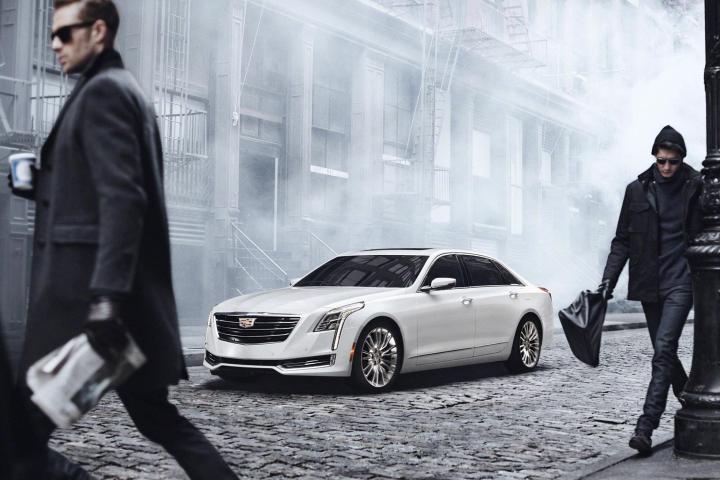
And how does it suppose to do that? By being very light indeed. Cadillac is quick to point out that the CT6 is as long as a standard wheelbase BMW 7 Series but weighs less than a 5 Series and boasts the stiffness of a British Royal Navy Admiral’s upper lip. That, for you who don’t know, is the most stiffness in the world.
The new, rigid Omega architecture that underpins the CT6 cradles a Caddy-exclusive 3.0-liter V6, producing an estimated 400 horsepower and as many torques. Though it is the most powerful V6 in its class, you may never hear it turning carbons into forward momentum, as Caddy claims the CT6 has “bank vault” levels of quietness. If I’m honest, this comparison tells me the men at Cadillac spend far too much quiet time in bank vaults with their money – kissing it, I presume. I mean, do you know how quiet a bank vault is? I surely do not.
All that power is routed to an eight-speed automatic transmission and out to all four 20-inch wheels – with active rear steering — through an active-on-demand all-wheel drive that features a continuously variable clutch that infinitely varies power delivery to the front wheels – up to 959 lb-ft. – to make the most of handling and stability in all conditions.
Wheels are pressed to the pavement by way of Cadillac’s Magnetic Ride Control. And for the laziest of Caddy drivers, the CT6 offers Auto Vehicle Hold. This system, according to Cadillac, is “a driver-selectable feature that prevents forward/rearward vehicle creep when the driver’s foot is off the brake. It reduces fatigue during heavy stop-and-go traffic and improves vehicle control on steep grades.”
Tech
Like any good, dynamic luxury sport sedan, Cadillac has crammed the CT6 with technology, which is centralized around the 10.2-inch CUE infotainment screen, which is controlled by a console-mounted touchpad.
The touchpad is just the tip of the tech iceberg, however. Cadillac has virtually coated the CT6 in cameras. In place of a standard, mirrored glass rear-view mirror, Cadillac has replaced it with a camera and screen system, which supposedly offers an unobstructed rear view.
The new model offers 360-degree camera view around the car, which, not only makes bump-free parking easier, can also be activated to record the vehicle surroundings when the security system is activated. So you and the kindly police officers can watch back in HD the baddies break into your car after they’ve finished doing their crimes.

If surround recordable cameras weren’t enough to keep your video obsession satiated, the CT6 offers Enhanced Night Vision incorporated into the driver information center, which will help drivers identify pedestrians and large animals in the dark.
Should you still not spot the pedestrian in your path, the CT6 will activate its New Pedestrian Collision Mitigation technology that activates brakes to avoid striking pedestrians. And during parking, New Advanced Park Assist will hit the brakes, should it detects the CT6 will collide with another car or obstacle – again, if you miss the visual cues.
In terms of tunes, Caddy — again — has you covered. The CT6 seems to have more speakers than cameras. In fact, it has 34 from Bose to be exact.
Looks
Every part of the CT6 was to inspire a passion for driving, so too does its long hood, sleek upper body and wide stance. Designers gave the car a vertical light signature in the front, which is reminiscent of the new Escalade.
In terms of looks, I rather like the look of the CT6. While perhaps not as good looking as, say, the CTS-V, it is still an excellent evolution of Cadillac’s Art & Science design language.
More to be seen
Honestly, there’s still much to be learned and seen of the new CT6. At the time this is written, I’ve not seen but one picture of the car. And though Cadillac leaned heavily on the discussion of the chassis design in its press release literature, all the special metal blends in the world mean nothing if it doesn’t drive as well as they claim. Obviously, this is something I cannot know at the moment.
To fill any gaps I might have left above, though, here’s what else we know about the latest, big ol’ Caddy. Along with the exclusive 400-hp V6, buyers will be able to spec either a 265-hp 2.0-liter inline four-cylinder or a 335-hp 3.6-liter naturally aspirated V6.
There are also to transmission options, both of which are eight-speeds. Only the top-notch eight, however, is bolted to the special twin-turbo V6.
The 2016 Cadillac CT6 will go into production in Hamtramck, Michigan later this year and pricing will be announced closer to the on-sale date.


